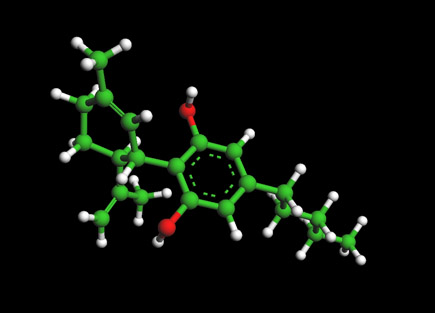Quercetin and Dasatinub-- Senolytic Properties
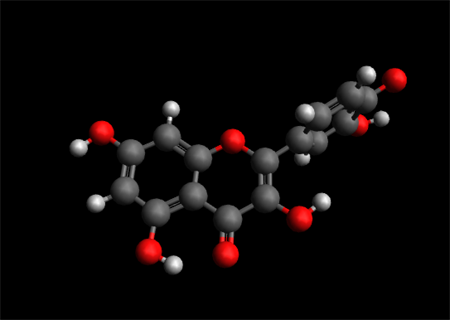
Ball and Stick Model for Honokiol Molecule
Quercetin is a flavonoid and, to be more specific, a flavonol.
Chemical structure -- molecular mass 302.236 g/mol
Molecular formula C15H10O7
Quercetin Molecular Structure

Overview of Quercetin
Quercetin is found to be the most active of the flavonoids in studies and many medicinal plants owe much of their activity to their high quercetin content. Quercetin has demonstrated significant anti-inflammatory activity because of direct inhibition of several initial processes of inflammation. For example, it inhibits both the manufacture and release of histamine and other allergic/inflammatory mediators. In addition, it exerts potent antioxidant activity and vitamin C-sparing action. Quercetin also shows anti-tumour properties. A study in the British Journal of Cancer showed that, when treated with a combination of quercetin and ultrasound at 20 kHz for 1 minute duration, skin and prostate cancers show a 90% mortality within 48 hours with no visible mortality of normal cells. Note that ultrasound also promotes topical absorption by up to 1,000 times making the use of topical quercetin and ultrasound wands an interesting proposition. See Quercetin as an Antioxidant Molecule
Quercetin is currently believed to only have weak senolytic properties when used by itself.
Bioavailability of Quercetin
"...Quercetin bioavailability varies widely between individuals. Gender may affect quercetin bioavailability, but there is no clear evidence. There has been little research looking for the effects of age and vitamin C status on bioavailability of quercetin supplements, but there is no research seeking out the effects of age and vitamin C status on bioavailability of food-derived quercetin. Presence of sugar moieties increases bioavailability and differences in quercetin-conjugated glycosides affect bioavailability. For instance, onion-derived quercetin, which is mainly quercetin glucoside, is more bioavailable than apple-derived quercetin, which contains quercetin rhamnoside and quercetin galactoside. Quercetin is lipophilic compound, thus dietary fat enhances its bioavailability. Nondigestible fiber may also improve quercetin bioavailability. Quercetin bioavailability is greater when it is consumed as an integral food component.... "see full abstract
Alpha-glycosyl-isoquercetin
Alpha-Glycosyl Isoquercitrin has 3 times the bioavailability of isoquercetin and nearly 18 times the bioavailability of quercetin aglycone.
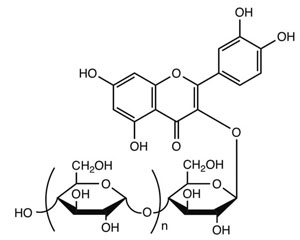
Image from: Comprehensive evaluation of theflavonol anti-oxidants,alpha-glycosylisoquercitrin and isoquercitrin, for genotoxic potential. See below for reference link and summary.
Dasatinub Molecule
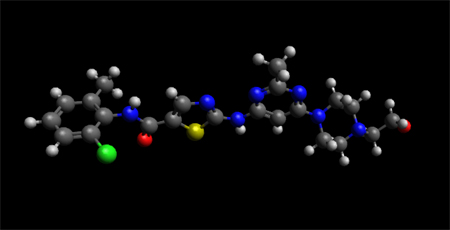
Ball and Stick Model for Dasatinib Molecule
Dasatinub Molecule (above) Ball-and-stick.
Molecular formula: C22H26ClN7O2S
Molar mass: 488.01 g/mol g·mol−1
Dasatinub Molecular Structure
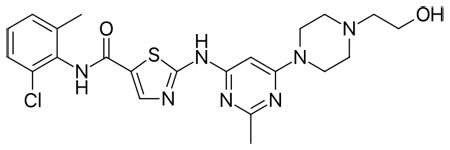
Overview of Dasatinub
Dasatinib is a highly effective second generation tyrosine kinase inhibitor approved for the treatment of imatinib-resistant or intolerant chronic myeloid leukemia and Philadelphia-positive acute lymphoblastic leukemia.
Cocktail of Dasatinub and Quercetin
The senolytic cocktail, dasatinib plus quercetin, which causes selective elimination of senescent cells, decreased the number of naturally occurring senescent cells and their secretion of frailty-related proinflammatory cytokines in explants of human adipose tissue... see below
Abstracts:
09 September 2019 --Senolytics improve physical function and increase lifespan in old age
"...Physical function declines in old age, portending disability, increased health expenditures, and mortality. Cellular senescence, leading to tissue dysfunction, may contribute to these consequences of aging, but whether senescence can directly drive age-related pathology and be therapeutically targeted is still unclear. Here we demonstrate that transplanting relatively small numbers of senescent cells into young mice is sufficient to cause persistent physical dysfunction, as well as to spread cellular senescence to host tissues. Transplanting even fewer senescent cells had the same effect in older recipients and was accompanied by reduced survival, indicating the potency of senescent cells in shortening health- and lifespan. The senolytic cocktail, dasatinib plus quercetin, which causes selective elimination of senescent cells, decreased the number of naturally occurring senescent cells and their secretion of frailty-related proinflammatory cytokines in explants of human adipose tissue. Moreover, intermittent oral administration of senolytics to both senescent cell–transplanted young mice and naturally aged mice alleviated physical dysfunction and increased post-treatment survival by 36% while reducing mortality hazard to 65%. Our study provides proof-of-concept evidence that senescent cells can cause physical dysfunction and decreased survival even in young mice, while senolytics can enhance remaining health- and lifespan in old mice...."-- from Nature Journal
September 2019 --Senolytics decrease senescent cells in humans: Preliminary report from a clinical trial of Dasatinib plus Quercetin in individuals with diabetic kidney disease
"...Senescent cells, which can release factors that cause inflammation and dysfunction, the senescence-associated secretory phenotype (SASP), accumulate with ageing and at etiological sites in multiple chronic diseases. Senolytics, including the combination of Dasatinib and Quercetin (D + Q), selectively eliminate senescent cells by transiently disabling pro-survival networks that defend them against their own apoptotic environment. In the first clinical trial of senolytics, D + Q improved physical function in patients with idiopathic pulmonary fibrosis (IPF), a fatal senescence-associated disease, but to date, no peer-reviewed study has directly demonstrated that senolytics decrease senescent cells in humans...“Hit-and-run” treatment with senolytics, which in the case of D + Q have elimination half-lives <11 h, significantly decreases senescent cell burden in humans." see full publication
15 July 2019 --Dasatinib and Quercetin: Short-Term Simultaneous Administration ImprovesPhysical Capacity in Human
"...Purpose: Senescent cells cause age-related pathologies.Theoretically,partialelimination of senescent cells mustlead to increased life capacity. This hypothesis wasconfirmed on Ercc1 -/Δ mice. Periodic simultaneousadministration of dasatinib and quercetin in Ercc1 -/Δmiceled to the extension of their healthspan, delaying age-related symptoms and pathologies. We decided to test thesenolyticeffect of dasatinib and quercetincombination onhuman beings...With this purpose, the clinical trial wasundertaken on 64 male volunteers over the age of 36. Toput things into perspective our volunteers were classifiedinto 4 groups with 16 people in each. D+Q group orallyadministered 50mg of dasatinib with 500 mg of quercetinonce a day within 5 days...As a result, 50 mg of dasatinib along with 500 mg ofquercetin demonstrated obvious senolyticeffect, it wasjustified by improved results of stair ascending test andtranquilized state of systolic blood pressure. Such dosagecombination of these two compounds is highly probable tobe harmless..." see full publication
March 2018 --Comprehensive evaluation of the flavonol anti-oxidants, alpha-glycosyl isoquercitrin and isoquercitrin, for genotoxic potential
"...Quercetin and its glycosides possess potential benefits to human health. Several flavonols are available to consumers as dietary supplements, promoted as anti-oxidants; however, incorporation of natural quercetin glycosides into food and beverage products has been limited by poor miscibility in water. Enzymatic conjugation of multiple glucose moieties to isoquercitrin to produce alpha-glycosyl isoquercitrin (AGIQ) enhances solubility and bioavailability. AGIQ is used in Japan as a food additive and has been granted generally recognized as safe (GRAS) status. However, although substantial genotoxicity data exist for quercetin, there is very little available data for AGIQ and isoquercitrin. To support expanded global marketing of food products containing AGIQ, comprehensive testing of genotoxic potential of AGIQ and isoquercitrin was conducted according to current regulatory test guidelines..." read full publication
Anti-Aging and Senolytics Home Page
- What is Anti-Aging Medicine
- What is Senescence?
- What are Senolytics?
- About Caloric Restriction
- Mtor and Rapamycin
- The IKK/NF-κB signaling pathway in aging
- Exercise and Anti-Aging
- Meditation and Anti-Aging
SENOLYTIC AND ANTI-AGING MOLECULES
RAPAMYCIN ---The mechanistic target of rapamycin (mTOR) pathway has a central role in cell activation...
METFORMIN -- The diabetes drug metformin used by some for anti-aging may diminish benefits of aerobic exercise...
QUERCETIN-- AND WITH DASATINIB--The senolytic cocktail, dasatinib plus quercetin, which causes selective elimination of senescent cells...
FISETIN--Of the 10 flavonoids tested, fisetin was the most potent senolytic...
EGCG- The most active component of green tea....
NAD BOOSTERS --'...The cells of the old mice were indistinguishable from the young mice, after just one week of treatment...
SULFORAPHANE-- An isothiocyanate present in cruciferous vegetables activates antioxidant and anti-inflammatory responses by ...
UROLITHIN --Metabolite of Pomegranate compound with anti-aging effects passes human trial...
MITO-Q -- A water soluble fomr of CoQ10 that has excellent absorption and high bioavailability...
HONOKIOL - A bioactive natural product derived from Magnolia Bark have demonstrated ...
CURCUMIN AND ANALOGS -Recent research is focused on the design and synthesis of curcumin analogs as antiproliferative and anti-inflammatory agents...
BERBERINE --berberine has recently been reported to expand life span in Drosophila melanogaster, and attenuate premature cellular senescence
N-ACETYL-CYSTINE (NAC)--"...pretreatment with NAC increased glutathione levels in the older cells and largely helped offset that level of cell death..."
PIPERLONGUMINE - A natural product from the Long pepper with high bioavailability...
RESVERATROL AND PTEROTSILBINE -- Pterostilben chemically similar to resveratrol bute differs from resveratrol by exhibiting increased bioavailability (80% compared to 20% in resveratrol)
SPERMIDINE--Spermidine delays aging in humans ...
ALLICIN -- Allicin is a compound produced when garlic is crushed or chopped. ...
VITAMIN D3 -- Production of the active forms of Vitamin D are reduced by 50% as a result of an age-related decline
VITAMIN K-- evidence suggests vitamin K has an anti-inflammatory action
TOCOTRIENOL(AND WITH QUERCETIN) --Tocotrieniols have been found to exert a synergistic antitumor effect on cancer cells when given in combination....
HSP-90 INHIBITORS --As a novel class of senolytics
The Cannabidiol Molecule
Cannabidiol (CBD is the major non-psychoactive component of Cannabis and is being looked at by major drug and consumer companies for various medical and social uses.